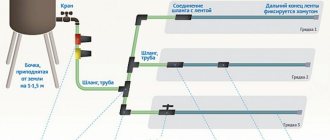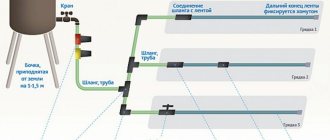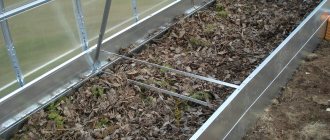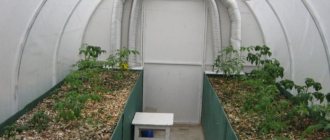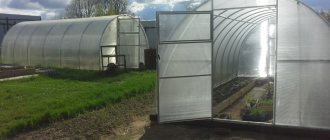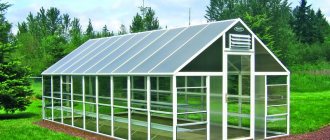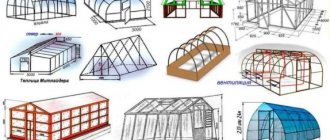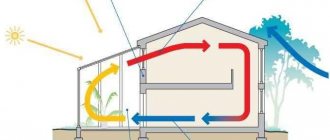A warm floor in a greenhouse is an excellent way to provide plants with a warm winter. The process of installing a heated floor is very similar to installing heating in a house or apartment, and the same tools are used for the work. But there is one difference - there are no requirements for the interior of the greenhouse, which greatly simplifies the insulation process. More details about the types of ground heating in a greenhouse, as well as methods for installing such systems, will be discussed in this article.
Warm floor in a greenhouse
Is it possible to have a heated floor in a greenhouse?
In winter, you cannot do without heating greenhouses. Various heating systems are used, but the most efficient and economical are heated floors. They create the necessary microclimate and evenly warm the soil.
Installing a heated floor in a greenhouse has many advantages:
- allows you to grow plants in any season;
- ensures rapid seed germination;
- leads to accelerated development and early fruiting of plants;
- creates suitable conditions for growing the most heat-loving crops;
- does not dry out the air and does not burn oxygen;
- reduces the risk of burns on leaves;
- reduces energy consumption.
In greenhouses with heated floors, conditions are created for crops to bear fruit all year round.
How to distribute the width of the greenhouse into beds and paths
The beds are usually placed along the greenhouse in such a way that the path dividing them stretches from the entrance to the opposite wall. If there are two beds, and the total width of the greenhouse is 3.1 m, there can be only one path.
In this case, the width of the beds is 1.06 m, the paths are 0.5 m. In a narrow 2.5-meter greenhouse, 0.75 m is allocated for 2 beds. In this case, minus the thickness of the walls and sides, 52 cm remains for the path .
The layout option with three beds assumes the presence of two paths, united by a turning part at the near wall. If there are three beds, with a greenhouse width of 3.44 m, their width will be no more than 0.66 m, and the paths - 0.45 m. In both cases, 40 mm wide sides are installed on the sides of the paths, as shown in the photo below.
Layout of greenhouses with two and three beds
Note: the sides are provided so that the soil moistened after watering does not crumble and is not trampled along the path. They are made from brick, concrete curbs, cut from sheet material that is not afraid of moisture: polycarbonate, flat slate, or assembled from pieces of plastic pipe or bottles filled with sand vertically dug into the ground. Some simply install boards on the edge, but they can quickly rot; this is a short-lived option.
Methods for heating soil
The main task of heating the soil in a greenhouse is to provide the desired temperature for the plants. It is important that the earth does not dry out when heated, so it is recommended to use combined heating.
To heat greenhouses, you can use different systems - warm floors (water, electric, infrared) or air heating .
Water floor
A warm water floor is a multilayer structure in which each layer plays its own role. The main element is a pipeline, through which coolant circulates. Pipes are made of metal, polymer and polycarbonate.
The floor pipeline is laid according to different patterns: “snail” or “snake”, and is connected to the manifold group, it is connected to the power source - boiler, boiler or central heating.
The advantages of hydrofloors in a greenhouse include uniform heating of the surface and vertical distribution of heat, which has a beneficial effect on plants. In addition, the floor water system is economical to operate and does not take up useful space.
The main disadvantage of such floors is the loss of room height due to the multi-layer structure of the “pie”. In addition, installation will not be cheap, since it will require the purchase of heating equipment and a pumping unit.
Electric floors
Electric floors - as the name suggests, they are powered by electrical energy. Due to high electricity tariffs, such models are rarely installed in greenhouses, although the installation itself is much simpler and more economical than water heating.
Electric floors are:
- Cable - a cable laid on the floor in a “snake” or “snail” pattern. The installation process is similar to laying a water floor.
The advantages of cable electric floors are durability, low cost and uniform heating. Disadvantages: electricity costs, labor-intensive installation.
- Cable mats - their difference from cable floors is that the wire is fixed to the grid according to a certain pattern, so the installation process is much easier.
- Infrared - carbon-coated film with a waterproof coating. The floor is easy to install and does not require screed. Emits heat in the form of infrared waves. Since the thermal efficiency of the infrared sheet is not high, the film is laid to a depth of no more than 15 - 20 cm, so there is a risk of mechanical damage during excavation work. The advantage of such systems is uniform heat distribution and energy savings.
To adjust electric floors, a thermostat with a sensor is required, this makes the adjustment process automatic.
The main condition for electric heating in a greenhouse is the presence of nearby electrical networks.
Air heating
Air heating is considered a simple way to heat greenhouses. It is not difficult to arrange such a structure yourself; in addition, it does not require a large investment of capital. But this model is only suitable for the spring-autumn period; for winter its warmth is not enough.
The principle of operation is the accumulation of heat that enters the greenhouse per day. The battery is a clay layer (200 mm); it is located under the plant cover.
The process looks like this:
- air masses move through asbestos pipes (100 - 200 mm in size) under the influence of a small fan;
- due to the gravity of the day, the air gives off heat through the walls of the pipes to the clay;
- at night - it transfers the accumulated heat to the beds.
To increase heating efficiency, thermal insulation material is placed under the clay.
This system can be operated in winter, but then it needs improvement and investment. To do this, you need to place a heater in the room - a gas or wood stove. The heat from it will pass through the pipes into the soil.
Bioheating
Bioheating is an economical method of maintaining the desired temperature level in a greenhouse. It is based on a biomaterial, the decomposition of which releases heat:
- weed clippings or fallen leaves;
- animal waste;
- sawdust.
In order to simultaneously maintain the temperature of the soil and air in the greenhouse at the desired level, it is recommended to install combined heating.
The disadvantage of such heating is the low temperature (+25), as well as the inability to regulate the degree of heating.
Types of heating systems
| Photo | Name | Rating | Price | |
| #1 | Water | ⭐ 99 / 100 | More details | |
| #2 | Electric | ⭐ 98 / 100 | More details | |
| #3 | Infrared | ⭐ 97 / 100 | More details | |
| #4 | Air | ⭐ 96 / 100 | More details |
There are several types of heated floors for greenhouses, but the basic ones include water, electric, infrared and, of course, air systems. Each type of heating is described separately below.
Water
The most universal underfloor heating system is water. With its help, heating water that is underground can be done in different ways: with a boiler, hot water from a pipeline or a good old boiler. But the technology for installing heated floors is the same, regardless of the method of heating the water.
Water heated floor in a greenhouse
Pipes for water heated floors are made of polymer or metal. Polymer is cheaper, but it does not transfer heat well. Therefore, experts recommend using steel. The pipes must be laid correctly so that the heat is distributed evenly.
Prices for pipes for heated floors Rehau
Pipes for heated floors Rehau
Electric
This is an expensive way to heat the ground, so electric cables are not used so often. Heated floors require copper wires that are evenly distributed across the floor surface of the greenhouse. But it is worth noting that not only the wires are expensive, you will also have to pay for electricity.
Electric heated floor in a greenhouse
On a note! Electric heating can also be provided by cable mats. This is a special design consisting of a metal mesh and wires.
Prices for heating mats "Teplolux"
heating mats "Teplolux"
Prices for heated floors REHAU
Warm floors REHAU
Infrared
Another way to insulate the floor in a greenhouse is using infrared film. It does not have a high thermal effect, so deep laying of the film is not required. The optimal depth for laying the film is 15-20 cm, so when performing greenhouse work there is a possibility of damage to such elements (for example, with a hoe or shovel).
Infrared heated floor in a greenhouse
The advantage of infrared heated floors is saving electricity. In addition, the generated heat is distributed evenly over the surface, which is very important for growing various greenhouse crops.
Types of IR film floors
Prices for infrared heated floors
infrared heated floor
Air
The principle of air heating is to install special ventilation devices on the foundation. Warm air is supplied upward through pre-installed sleeves made of polyethylene. Perforated hoses are usually installed in the lower section of a heated greenhouse.
Air heating in a greenhouse
Which heating system to choose and why
When choosing a warm floor for a greenhouse, you need to take into account not only your financial capabilities, but also the characteristics of the greenhouse space and its location. In addition, an important indicator is the cost of the coolant.
If there is a source with hot heat supply nearby, the choice suggests itself in the direction of a water floor. Even if there is only cold water, this option is preferable, because it is enough to install an inexpensive water heater.
If there is no water supply, and if there is a power supply nearby, you should choose electric floors. Cable models are recommended for heating large greenhouses. To effectively heat the soil, the power of cable systems must be at least 75 watts per m2. If the greenhouse is small, then you can lay the film, since it can heat a small room, and its installation is not difficult.
More often, electric heating is used where a multi-tariff meter is installed, then the cost of heating the greenhouse at night will be less.
Heating the soil in a greenhouse
